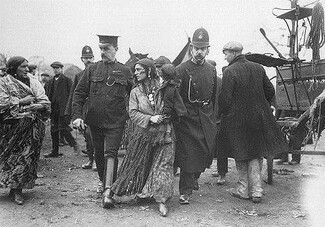Seeing the Past – Gypsies and Travellers through non-Gypsy eyes

By JODIE MATTHEWS
I grew up in Worcestershire, where many Gypsy and Traveller families have a long history of living and working. It was not uncommon to hear racism towards Gypsies and Travellers.
Later, when I went to university and became interested in Victorian literature, I began to notice just how many Gypsy characters featured in these novels. There seemed to be a fascination amongst non-Gypsy writers and artists, and their readers and viewers, with Gypsy culture.
The collected descriptions of people wanting to run away with Gypsies (for instance in George Eliot’s The Mill on the Floss), dress up as Gypsies (in Charlotte Brontë’s Jane Eyre), romanticise Gypsies or paint them as villains was impossible to ignore. Sometimes this attention was respectful, sometimes it was prurient – almost never were the voices of Gypsies and Travellers heard without the filter of whoever was writing or making an image.
I wondered about the relationship between the late twentieth-century racism I had witnessed and these (sometimes exploitative) representations from the past. This developed into PhD research, and I have continued to investigate the ways in which Gypsy and Traveller individuals and culture have been represented in Britain – in novels, newspapers, and art. I usually look at representations from the 1800s, but I believe that it is important to examine how these words and images from the past relate to the ways in which Gypsies and Travellers are seen today, from Glue and Peaky Blinders on television, to Jerusalem on stage, Stone Cradle in the novel form, and The Basin on the radio.
Nineteenth-century newspapers and periodicals like the Illustrated London News ran frequent articles about ‘Gypsy life’, sometimes on a weekly basis so that readers could follow the series like a soap opera. Some of these related to the work of the zealous social reformer George Smith of Coalville, who campaigned to change what he saw as the uncivilized and unsanitary Gypsy way of life. He campaigned similarly on behalf of canal boat children. His pamphlets and speeches were quoted next to engraved illustrations of Gypsy families going about their business.
Middle-class readers were expected to be horrified and enticed at the same time, as was often the case with representations of Gypsies and Travellers made by outsiders, and is something that continues to this day. Desire and fear are two sides of the same coin in these pictures and descriptions.
Other articles were written by or in praise of the ‘Gypsy lorists’, men like Theodore Watts-Dunton and Charles Godfrey Leland who professed an affinity with Gypsy culture and stayed and talked with various families. They made the effort to learn the Romani language, but they produced romanticised pictures of Gypsy life and felt that they knew better than the Gypsies themselves what value and meaning their cultural practices had.
Newspaper collections are held in university libraries across the country and some, like Liverpool and Leeds, have special collections of documents that represent Gypsy and Traveller life from the past, available to view by appointment or as part of exhibitions – their websites have details and the archivists can help find particular sources. Many of the newspapers featuring stories about Gypsy and Traveller history have been digitized and are online, but either a subscription or university login is required to access them. I wonder how easy it is for communities to access images from their own pasts, and how much of it is locked away where only academics and experts can find them.
The images in books, newspapers and pamphlets in Victorian Britain often portrayed Gypsy and Traveller people in very stereotypical ways – fortune-telling women in bright headscarves and low-cut dresses, wild children, and swarthy, frowning men up to no good. They emphasized what they thought was different and exotic about Gypsy culture, rather than the ways in which it overlapped with other ways of life in Britain at the time. These tend to be the aspects of Gypsy and Traveller history that get remembered, partly because these images made by people who weren’t Gypsies and Travellers are the ones that get saved in archives for us to see hundreds of years later. Those writers and illustrators had the power to represent others, and the power to preserve those representations.
I’m always interested to talk to people about representations of Gypsies and Travellers, so contact me on j.matthews|@hud.ac.uk if you want to know more or have views to offer.